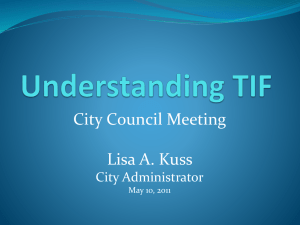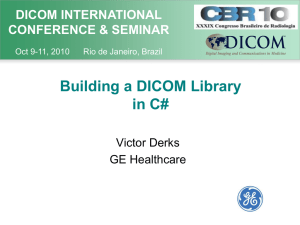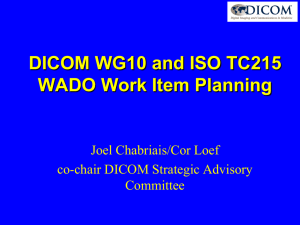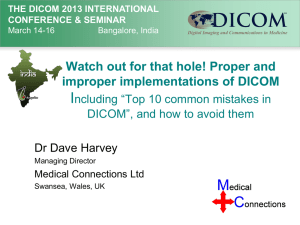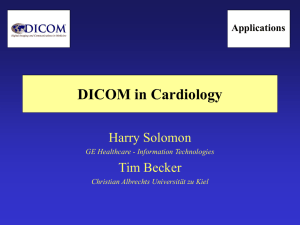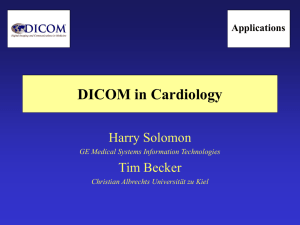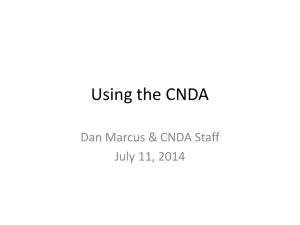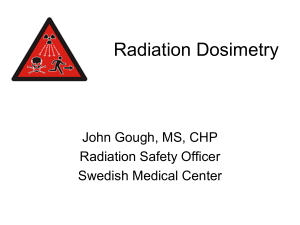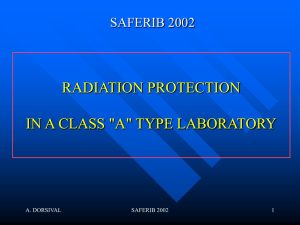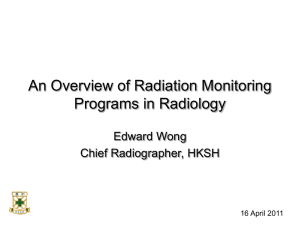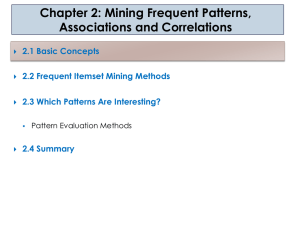Measurements, CAD, Radiation Dose and more
advertisement
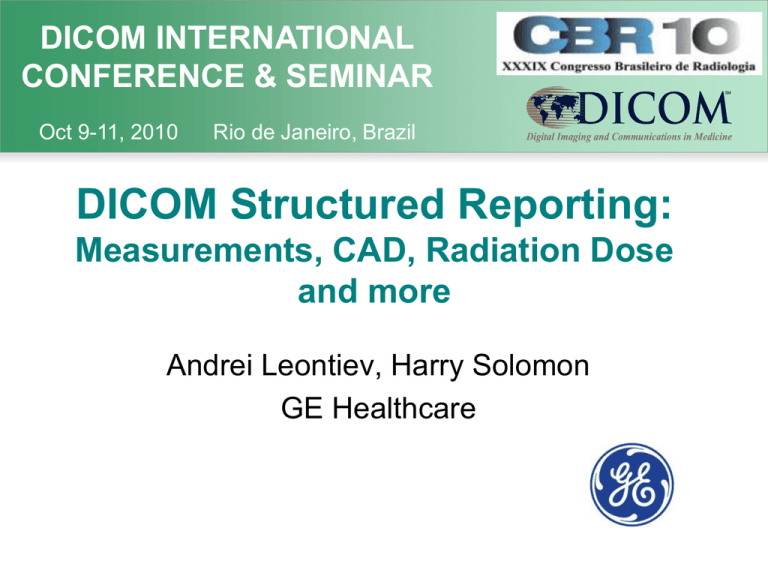
DICOM INTERNATIONAL CONFERENCE & SEMINAR Oct 9-11, 2010 Rio de Janeiro, Brazil DICOM Structured Reporting: Measurements, CAD, Radiation Dose and more Andrei Leontiev, Harry Solomon GE Healthcare Structured Reporting • DICOM Structured Reporting (SR) is an encoding for non-imaging content: – Observations made in an imaging-based diagnostic or therapeutic procedure – Analytic or diagnostic reports – Other types of documentation • Not limited to (clinical) “reports” – Any type of structured data or results When to use DICOM SR • For structured data produced with image acquisition or post-processing, where: – Leveraging the DICOM infrastructure is easy and desirable – Results should be managed with other study evidence • Examples – – – – – Sonographer measurements Computer-aided detection results Quality control notes about images Radiation dose reports Image exchange manifests DICOM SR Document • Each SR object represents a document • As other DICOM objects, SR Document is composite object fitting Patient-Study-Series hierarchical model – Lowest level is “Document”, rather than “Image” • The content of a document is a tree of Content Items connected via Relationships – The content tree always has a single root Content Item which serves as a container for all other items The SR Content Tree Standard DICOM Header Patient Study Series Document Content Items are units of meaning … Text, Numeric, Code, Image, Spatial coordinates, etc. … or units of structure Container Arrows are parent-child Relationships Contains, Has properties, Inferred from, etc. Root Content Item Container Content Item Content Item Content Item Content Item Content Item Content Item Content Item Content Item Content Item Root Content Item is a Container whose name is the name of the document Content Tree Example Patient Jones^Jane Study 1.2.34.5.67.8.100 Series 1.2.34.5.67.9.10 Document Author: Smith^R^^^MD Initial Observation Context is set by the Header: • Subject (patient) • Procedure • Observer (author) Chest X-Ray Exam Report Views: PA & Lat Findings Mass Location = Left lower lobe Size = 1.3 cm Key Images Best Illustration: 1.2.34.5.67.1.3 Conclusions Probable Malignancy Relationships: Concept Modifier Contains Properties Content Items • The Content Item is the building block of the SR Document • Provides a name-value pair, i.e., a Concept Name, and a Concept Value of a particular Value Type – Equivalent to a DICOM Data Element, at higher level of abstraction – Concept Name ≡ Attribute Tag – Concept Value ≡ Data Element Value – Value Type ≡ Value Representation • Concept Name is drawn from a coded controlled vocabulary system – Nomenclature, lexicon, terminology, classification Content Item Value Types • Container (document section, group of other items) – [Social History] CONTAINER • Text (words, sentences or paragraphs) – [Recommendation] TEXT “Follow up in three months with …” • Numeric (measurements) – [Left Ventricular Ejection Fraction] NUM 45% • Code (qualitative or categorical concepts) – [Breast Composition] CODE [Heterogeneously dense] • Date, time – [Prior Myocardial Infarction] DATE 2005-11-17 • Person Name – [X-Ray Technician] PNAME Levin^Henry^^^RT • Reference to images and other objects – [Best Illustration of Finding] IMAGE <SOPClassUID,SOPInstanceUID> • Spatial and time coordinates (within referenced images) – [Area of measurement] SCOORD <coordinates> selected from IMAGE Coded Values • SR leverages coded values from controlled vocabulary systems – For both Concept Names and CODE Concept Values • Vocabulary systems used include: – SNOMED (Systematized Nomenclature of Medicine) • T-11501 “Cervical spine” – LOINC (Logical Observation Identifier Names and Codes) • 8462-4 “Intravascular diastolic blood pressure” – UCUM (Unified Code for Units of Measure) • mg/ml – DICOM Content Mapping Resource (DICOM-specific concepts) • 113040 “Lossy Compression” – IEEE 11073 (Point-of-Care Medical Device Nomenclature) • 2:16164 “QTc interval global” – IETF RFC3066 (Identification of Languages) • pt-BR “Portuguese, Brazil” Relationships • Relationships are the glue between the Content Item building blocks • Relationship types include: – Containment (in a container) – Modification/qualification of the Concept Name • Allows “post-coordination” construction of complex concepts – Observation Context • Identifying the subject or the author of the observation – Inference • Content of one Item derived from other item(s) – Properties of the parent observation OB-GYN SR Example Encoded with DICOM attributes Hierarchical tree structure of Content Items and Relationships External codes (LOINC) Measurements with related method and statistical properties The Problem of SR Flexibility • DICOM SR is very powerful – a document creator can record any content in a variety of structures • A document reader must handle every possible document • Need to constrain the SR structure and content to enable meaningful receiving applications • This is purpose of Templates Templates • DICOM defines Templates to standardize appropriate structure and content for specialized applications – Often developed in collaboration with a professional society • Templates are similar to DICOM Information Object Definitions and Modules – Define Content Items as required/optional, and allowed values – Specify hierarchical structure of sections and subsections – Templates may be extensible (allow additional information beyond what is defined in the template), or non-extensible • Context Groups are sets of coded values used in the templates Standard Templates • DICOM Part 16 has over 250 defined Templates, and over 800 associated value sets (Context Groups). Examples: – – – – – – – – – – – – TID 2000 Basic Diagnostic Imaging Report TID 2010 Key Object Selection TID 2100 Macular Grid Thickness and Volume Report TID 3001 Cardiac Cath Procedure Log TID 3300 Cardiac Stress Testing Report TID 3900 CT/MR Cardiovascular Analysis TID 4000 Mammography CAD TID 4120 Colon CAD TID 5000 OB-GYN Ultrasound Procedure Report TID 5100 Vascular Ultrasound Report TID 10001 Projection X-Ray Radiation Dose TID 10011 CT Radiation Dose Typical Top Level Template Structure CONTAINER Document Title … Template specified title OB-GYN, Adult Echo, IVUS Ultrasound Vascular, Cath/Hemo … CONTAINER Patient Characteristics CONTAINER Procedure Context CONTAINER Summary CONTAINER CONTAINER CONTAINER Findings Heading Finding FindingHeading Heading … … … … TID 1002 Observation Context Vital Signs, Presentation Procedure Method Summary Findings Findings, Measurements DICOM SR SOP Classes • Basic Text, Enhanced and Comprehensive - General use – Text, coded content, numeric measurements, spatial and temporal ROI references (any template) • CAD - Automated analysis results – SOP Class per CAD template (TID 4000 Mammo, TID 4100 Chest, TID 4120 Colon) • Key Object Selection - Flags one or more images – Purpose (“for referring physician”, “for surgery”, …) and textual note (TID 2010 only) • Procedure Log – Time-based event log for extended duration procedures (TID 3001) • Radiation Dose Report - Projection X-ray; CT – TID 10001 Projection X-Ray, TID 10011 CT Radiation Dose SR in workflows • We know how to use images in radiology workflows – it is not so obvious how to effectively use SR • Integrating the Healthcare Enterprise (IHE) is developing use-case based workflow profiles – IHE is a professional-industry collaboration that includes the DICOM Standards Committee – Workflows tested at IHE Connect-a-thons – Request IHE workflow profiles in your equipment purchases / upgrades Post-Processing Results • Measurements and coded data created at either acquisition modality or workstation – OB-GYN, Vascular, Cardiac Ultrasound Measurements – Mammo, Chest, Colon CAD – Cardiovascular CT/MR Measurements • Stored in PACS with other study data (images) as “evidence documents” • Interpreted along with the images – Significant observations copied into clinical report • Evidence Documents Profile Key Object Selection Documents • Conveys a list of DICOM Composite Objects grouped together for a stated purpose – Intent of selection is in SR Title; also includes simple textual note – Non-extensible template TID 2010 – keep it simple! – Identified by its own SOP Class UID, and its own modality “KO” • Use Cases – Technologist Note – comment to radiologist, electronic equivalent of Post-It™ on film jacket (KIN Profile) – Radiologist Key Image Note – list of key images for report or consultation to PACS (KIN Profile) – Quality Control Note – identify images to not be used, e.g., from mammo QC workstation (MAWF Profile) – Study Content Manifest – list of images available for sharing through a Health Information Exchange (XDS-I Profile) – Export List – list of images for export to teaching file or clinical trial (TCE Profile) Radiation Dose Report • Radiation Dose Report is an SR Document – Created by a modality to record the Radiation Dose delivered to a patient during imaging procedure; stored to the PACS – Provides more comprehensive information than attributes in an image header or in the MPPS – Encoded with specific SOP Class UID to allow easy access by dose management applications • Workflow specified in IHE Radiation Exposure Management (REM) Profile – New workflow actor: Dose Information Reporter for analysis and management (“dashboard”) • DICOM Radiation Dose Report may soon be required by regulation in some countries Radiation Dose Report Content • Specific templates for different Modalities: Projection X-Ray (XA, CR, DX, MG) or CT • Conveys cumulative dose information as well as details of each irradiation event • The irradiation event is the “smallest” information entity recorded in the realm of Radiation Dose reporting – For example, a CT irradiation event is one continuous irradiation procedure (scan) with consistent acquisition parameters • Content Items allow aggregation for comparative statistics by device, operator, protocol, etc. Diagnostic Reports • SR infrastructure supports creation and interchange of diagnostic report documents – Simple structure of section headings and paragraphs – Measurements and coded content items on different levels to support data mining and statistical analysis – Robust image references – Storable in PACS with study – IHE Simple Image and Numeric Report Profile • But needs transcoding/rendering to a displayable format for non-DICOM access – E.g., HL7 Clinical Document Architecture XML Putting DICOM SR into Practice • DICOM SR is a potentially powerful addition to the interoperability environment • Use IHE use case driven profiles as basis for requests for information (RFI) from vendors – Start with your high priority issues, e.g., radiation dose, or sonographer worksheet measurements • Many profiles have implementation in some workflow actors, but not a full end-to-end capability – Evidence Documents widely implemented in new ultrasound systems, but not in ultrasound analysis and reporting applications – Radiation Dose Reports are being implemented in modalities, but still need the analysis and management applications – Vendors will respond to customer requests – ask for this from the missing link systems
